CBE hosted the final round of its 3rd Data Analytics Competition in Stephens Hall on April 22, 2022. The event was sponsored by the Baltimore Ravens and this semester’s competition brought together 135 students across five TU colleges. The competition featured Cody Williams, Director of Business Intelligence at Ravens who developed the case based on a dataset of Ravens merchandise and apparel sales. The students were tasked with deriving insights through data analysis and pitch ideas of how to drive other opportunities for local sales revenue.

In the initial round, all submissions of data analysis were judged by the Ravens, with the top 10 teams invited to deliver their final presentations in-person. During the final round, the top three winning teams were selected based on the creativity and utility of data visualization, the clarity and quality of analysis and storytelling, and the originality of recommendations.
Results:
1st: Astrid Nina (CBE)
2nd: Brittney Workman (CLA)
3rd: Julia O’Connell (COFAC), Leah Sine (CBE), and Haja Sannoh (CBE/CLA)
CBE was able to award $5,000 in scholarships to these students.
After the final presentations, competitors, attendees, and judges were able to interact and network to further discuss all things data and analytics. After observing and conversing with the students, Williams says, “I am hugely impressed by the skill level of the students and where they are today compared to this field ten years ago when I was in college. Analytics was not necessarily even a major offered when I was in school. To see college students producing this quality of analysis work, visualization work, presentation skills, I am very impressed. I feel as though they are all going to be ready and prepared to enter the workforce and contribute right away and do a great job”
First place winner, Astrid Nina, expressed that she became interested in this competition after seeing all of the other competitions CBE has hosted. She felt that her previous courses prepared her to succeed in the task given.
Nina expressed, “The data in general was really fun to work with. From doing everything to gather insights in order to see and do what they were asking us to do and then actually figuring it out.”
She also benefited from networking after the event and believes the competition could impact her future. She adds, “Doing analysis, visualization, and storytelling is something that I am really interested in and I asked him about if they have any opportunities at the moment and he said yes. I will definitely apply, it is an internship opportunity and I am a senior looking for an internship. I am excited about that.”
As the field of data analytics continues to grow, Williams believes that it is imperative to have competitions like this to not only help inform students of real world situations but to also to place importance on analytics in business. He says, “Data and analytics is Paramount. It is hard to imagine businesses operating today without using data to make informed decisions. The techniques, technology, tools, it becomes even more powerful and I think that we will only continue to rely on data more and more to move forward and that is why I am excited to see students really invest in their education in data and analytics and some of these other things because it is the future and the present.”

As analytics continues to impact our everyday lives, the College is proud to offer both a business analytics minor, open to all TU students, and a business analytics track under the business administration major. To learn more, visit our website.
Written by: Millie Klefsaas




 Our next star student is Nico Boone. Boone is a Business Administration major with a concentration in Entrepreneurship. He says “ I’ve always enjoyed the many aspects of business and wanted to educate myself on how to be a successful entrepreneur. I knew the faculty and staff would be able to help me develop and provide opportunities for me to exercise my skill set.”
Our next star student is Nico Boone. Boone is a Business Administration major with a concentration in Entrepreneurship. He says “ I’ve always enjoyed the many aspects of business and wanted to educate myself on how to be a successful entrepreneur. I knew the faculty and staff would be able to help me develop and provide opportunities for me to exercise my skill set.” 